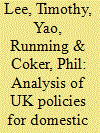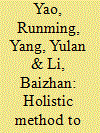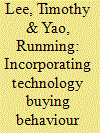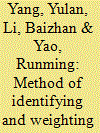|
|
|
Sort Order |
|
|
|
Items / Page
|
|
|
|
|
|
|
| Srl | Item |
| 1 |
ID:
127907


|
|
|
|
|
| Publication |
2014.
|
| Summary/Abstract |
This paper introduces a new agent-based model, which incorporates the actions of individual homeowners in a long-term domestic stock model, and details how it was applied in energy policy analysis. The results indicate that current policies are likely to fall significantly short of the 80% target and suggest that current subsidy levels need re-examining. In the model, current subsidy levels appear to offer too much support to some technologies, which in turn leads to the suppression of other technologies that have a greater energy saving potential. The model can be used by policy makers to develop further scenarios to find alternative, more effective, sets of policy measures. The model is currently limited to the owner-occupied stock in England, although it can be expanded, subject to the availability of data.
|
|
|
|
|
|
|
|
|
|
|
|
|
|
|
|
| 2 |
ID:
113438


|
|
|
|
|
| Publication |
2012.
|
| Summary/Abstract |
The assessment of building energy efficiency is one of the most effective measures for reducing building energy consumption. This paper proposes a holistic method (HMEEB) for assessing and certifying energy efficiency of buildings based on the D-S (Dempster-Shafer) theory of evidence and the Evidential Reasoning (ER) approach. HMEEB has three main features: (i) it provides both a method to assess and certify building energy efficiency, and exists as an analytical tool to identify improvement opportunities; (ii) it combines a wealth of information on building energy efficiency assessment, including identification of indicators and a weighting mechanism; and (iii) it provides a method to identify and deal with inherent uncertainties within the assessment procedure. This paper demonstrates the robustness, flexibility and effectiveness of the proposed method, using two examples to assess the energy efficiency of two residential buildings, both located in the 'Hot Summer and Cold Winter' zone in China. The proposed certification method provides detailed recommendations for policymakers in the context of carbon emission reduction targets and promoting energy efficiency in the built environment. The method is transferable to other countries and regions, using an indicator weighting system to modify local climatic, economic and social factors.
|
|
|
|
|
|
|
|
|
|
|
|
|
|
|
|
| 3 |
ID:
117250


|
|
|
|
|
| Publication |
2013.
|
| Summary/Abstract |
The UK has a target for an 80% reduction in CO2 emissions by 2050 from a 1990 base. Domestic energy use accounts for around 30% of total emissions. This paper presents a comprehensive review of existing models and modelling techniques and indicates how they might be improved by considering individual buying behaviour. Macro (top-down) and micro (bottom-up) models have been reviewed and analysed. It is found that bottom-up models can project technology diffusion due to their higher resolution. The weakness of existing bottom-up models at capturing individual green technology buying behaviour has been identified. Consequently, Markov chains, neural networks and agent-based modelling are proposed as possible methods to incorporate buying behaviour within a domestic energy forecast model. Among the three methods, agent-based models are found to be the most promising, although a successful agent approach requires large amounts of input data. A prototype agent-based model has been developed and tested, which demonstrates the feasibility of an agent approach. This model shows that an agent-based approach is promising as a means to predict the effectiveness of various policy measures.
|
|
|
|
|
|
|
|
|
|
|
|
|
|
|
|
| 4 |
ID:
101462


|
|
|
|
|
| Publication |
2010.
|
| Summary/Abstract |
This paper describes a method of identifying and weighting indicators for assessing the energy efficiency of residential buildings in China. A list of indicators of energy efficiency assessment in residential buildings in the hot summer and cold winter zone in China has been proposed, which supplies an important reference for policy makings in energy efficiency assessment in buildings. The research method applies a wide-ranging literature review and a questionnaire survey involving experts in the field. The group analytic hierarchy process (group AHP) has been used to weight the identified indicators. The size of survey samples are sufficient to support the results, which has been validated by consistency estimation. The proposed method could also be extended to develop the weighted indicators for other climate zones in China.
|
|
|
|
|
|
|
|
|
|
|
|
|
|
|
|
|
|
|
|
|